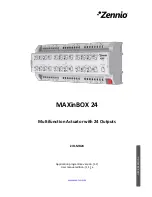
Monitoring Status and Statistics
D-Link
Unified Wired and Wireless Access System
Oct. 2015
Page 446
D-Link UWS User Manual
Table 258: Global WLAN Status/Statistics
Field
Description
WLAN Switch
Operational Status
This status field displays the operational status of the WLAN Switch. The WLAN
Switch may be configured as enabled, but is operationally disabled due to
configuration dependencies. If the operational status is disabled, the reason will be
displayed in the following status field.
The WLAN Switch is composed of multiple components, and each component in the
system must acknowledge an enable or disable of the WLAN Switch. During a
transition the operational status might temporarily show a pending status.
WLAN Switch
Disable Reason
If the status is disabled, this field appears and one of the following reasons is listed:
• None: The cause for the disabled status is unknown.
• Administrator disabled: The Enable WLAN Switch option on the global
configuration page has been cleared.
• No IP Address: The WLAN interface does not have an IP address.
• No SSL Files: The DWS-4000 Series switch communicates with the APs it manages
by using Secure Sockets Layer (SSL) connections. The first time you power on the
DWS-4000 Series switch, it automatically generates a server certificate that will
be used to set up the SSL connections. The SSL certificate and key generation can
take up to an hour to complete.
If routing is enabled on the switch, the operational status might be disabled due to
one of the following reasons:
• No Loopback Interface: The switch does not have a loopback interface.
• Global Routing Disabled: Even if the routing mode is enabled on the WLAN switch
interface, it must also be enabled globally for the operational status to be
enabled.
IP Address
IP address of the switch.
Peer Switches
Number of peer WLAN switches detected on the network.
Cluster Controller
Indicates whether this switch is the Cluster Controller for the cluster.
Among a group of peer switches, one of the switches is automatically elected or
configured to be the Cluster Controller. The Cluster Controller gathers status and
statistics about all APs and clients in the peer group.
Note:
Only the Cluster Controller switch can display managed APs, clients, statistics,
and RF Scan databases for the whole cluster. The switches that are not Cluster
Controllers can display information only about locally attached devices.
Cluster Controller IP
Address
The IP address of the peer switch that is the Cluster Controller.
Total Access Points
Total number of Managed APs in the database. This value is always equal to the sum
of Managed Access Points, Connection Failed Access Points, and Discovered Access
Points.
Managed Access Points
Number of APs in the managed AP database that are authenticated, configured, and
have an active connection with the Unified Switch.
Standalone Access
Points
Number of trusted APs in Standalone mode. APs in Standalone mode are not
managed by a switch.
Rogue Access Points
Number of Rogue APs currently detected on the WLAN. When an AP performs an RF
scan, it might detect access points that have not been validated. It reports these APs
as rogues.
















































